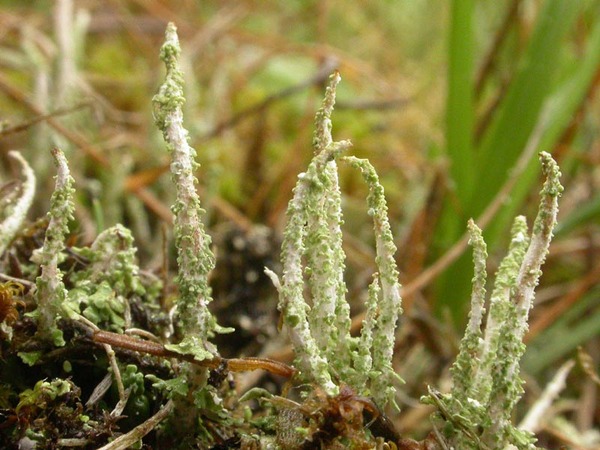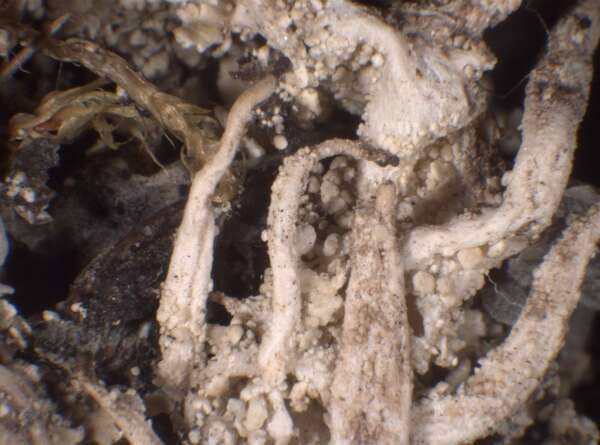Cladonia decorticata (Flörke) Spreng.
Syst. Veget., 4, 1: 273, 1827. Basionym: Capitularia decorticata Flörke - Beitr. Naturk., 2: 297, 1810.
Synonyms:
Description: Primary thallus squamulose, persistent or evanescent, the squamules 1.5-3(-4) mm long 1-2 mm broad, irregularly divided, usually becoming concave, glaucescent or olive-green on upper side, white beneath, often darkening towards the attachment point. Podetia frequent, bacilliform, hollow inside with a very narrow, <10 μm wide central canal, pale grey to whitish grey, not melanotic at base, 4-10(-15) mm tall, 0.5-1 mm thick, usually cupless, sometimes with a few apical branches and open axils, with a verruculose cortex, the warts dispersed, tending to become subsquamulose-phyllidiate. Apothecia very rare, dark brown, convex, terminal. Asci 8-spored, clavate, thickened at apex, with a K/I+ blue tholus and a K/I+ strongly blue outer gelatinous sheath, Cladonia-type. Ascospores 1-celled, hyaline, ellipsoid. Pycnidia rare, mostly on primary squamules, constricted at base, with a colourless jelly. Conidia hyaline, curved. Photobiont chlorococcoid. Spot tests: K-, C-, KC-, P-, UV+ ice-blue. Chemistry: perlatolic acid and three unknown compounds.
Growth form: Fruticose
Photobiont: green algae other than Trentepohlia
Reproductive strategy: mainly asexual, by soredia, or soredia-like structures (e.g. blastidia)
Commonnes-rarity: (info)
Alpine belt: very rare
Subalpine belt: very rare
Montane belt: extremely rare
Dry submediterranean belt: absent
Humid submediterranean belt: absent
Padanian area: absent
pH of the substrata:
1 2 3 4 5
Solar irradiation:
1 2 3 4 5
Aridity:
1 2 3 4 5
Eutrophication:
1 2 3 4 5
Poleotolerance:
0 1 2 3
Altitudinal distribution:
1 2 3 4 5 6
Rarity
absent
extremely rare
very rare
rare
rather rare
rather common
common
very common
extremely common
Loading data...
Occurrence data
Predictive map
Growth form: Fruticose
Photobiont: green algae other than Trentepohlia
Reproductive strategy: mainly asexual, by soredia, or soredia-like structures (e.g. blastidia)
Commonnes-rarity: (info)
Alpine belt: very rare
Subalpine belt: very rare
Montane belt: extremely rare
Dry submediterranean belt: absent
Humid submediterranean belt: absent
Padanian area: absent
pH of the substrata:
| 1 | 2 | 3 | 4 | 5 |
Solar irradiation:
| 1 | 2 | 3 | 4 | 5 |
Aridity:
| 1 | 2 | 3 | 4 | 5 |
Eutrophication:
| 1 | 2 | 3 | 4 | 5 |
Poleotolerance:
| 0 | 1 | 2 | 3 |
Altitudinal distribution:
| 1 | 2 | 3 | 4 | 5 | 6 |
Rarity
absent
extremely rare
very rare
rare
rather rare
rather common
common
very common
extremely common
Loading data...
Occurrence data
Predictive map








